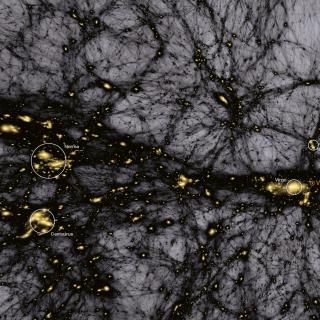Bibcode
Bernardinelli, Pedro H.; Bernstein, Gary M.; Jindal, Nicholas; Abbott, T. M. C.; Aguena, M.; Alves, O.; Andrade-Oliveira, F.; Annis, J.; Bacon, D.; Bertin, E.; Brooks, D.; Burke, D. L.; Carnero Rosell, A.; Carrasco Kind, M.; Carretero, J.; da Costa, L. N.; Pereira, M. E. S.; Davis, T. M.; Desai, S.; Diehl, H. T.; Doel, P.; Everett, S.; Ferrero, I.; Friedel, D.; Frieman, J.; García-Bellido, J.; Giannini, G.; Gruen, D.; Herner, K.; Hinton, S. R.; Hollowood, D. L.; Honscheid, K.; James, D. J.; Kuehn, K.; Marshall, J. L.; Mena-Fernández, J.; Menanteau, F.; Miquel, R.; Ogando, R. L. C.; Palmese, A.; Pieres, A.; Plazas Malagón, A. A.; Raveri, M.; Sanchez, E.; Sevilla-Noarbe, I.; Smith, M.; Suchyta, E.; Swanson, M. E. C.; Tarle, G.; To, C.; Walker, A. R.; Wiseman, P.; Zhang, Y.; DES Collaboration
Bibliographical reference
The Astrophysical Journal Supplement Series
Advertised on:
11
2023
Citations
21
Refereed citations
18
Description
We report the methods of and initial scientific inferences from the extraction of precision photometric information for the >800 trans-Neptunian objects (TNOs) discovered in the images of the Dark Energy Survey (DES). Scene-modeling photometry is used to obtain shot-noise-limited flux measures for each exposure of each TNO, with background sources subtracted. Comparison of double-source fits to the pixel data with single-source fits are used to identify and characterize two binary TNO systems. A Markov Chain Monte Carlo method samples the joint likelihood of the intrinsic colors of each source as well as the amplitude of its flux variation, given the time series of multiband flux measurements and their uncertainties. A catalog of these colors and light-curve amplitudes A is included with this publication. We show how to assign a likelihood to the distribution q(A) of light-curve amplitudes in any subpopulation. Using this method, we find decisive evidence (i.e., evidence ratio <0.01) that cold classical (CC) TNOs with absolute magnitude 6 < H r < 8.2 are more variable than the hot classical (HC) population of the same H r , reinforcing theories that the former form in situ and the latter arise from a different physical population. Resonant and scattering TNOs in this H r range have variability consistent with either the HCs or CCs. DES TNOs with H r < 6 are seen to be decisively less variable than higher-H r members of any dynamical group, as expected. More surprising is that detached TNOs are decisively less variable than scattering TNOs, which requires them to have distinct source regions or some subsequent differential processing.
Related projects

Cosmology with Large Scale Structure Probes
The Cosmic Microwave Background (CMB) contains the statistical information about the early seeds of the structure formation in our Universe. Its natural counterpart in the local universe is the distribution of galaxies that arises as a result of gravitational growth of those primordial and small density fluctuations. The characterization of the
FRANCISCO SHU
KITAURA JOYANES